|
Displaying items by tag: Boston
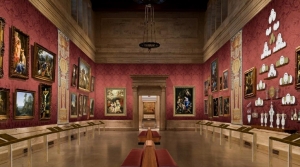
There was a time when Anthony Van Dyck’s Isabella, Lady de La Warr was considered one of the most important paintings at Boston’s Museum of Fine Arts. Purchased in 1930 for $121,440 by the MFA donor, Mrs. Frederick T. Bradbury, the work went on view in the Hamilton Palace period room. It wasn’t until the 1980s when the painting went into storage that Isabella’s future started to look bleak.
When Malcolm Rogers rediscovered Isabella not long after he took over as the MFA’s director in 1994, he found the painting’s surface was discolored from protective varnishes and shoddy retouching had left the work with mismatched paint. Painted by the Flemish artist in 1638 during a stay in England, Rogers knew that Isabella could be recovered. A technical examination in 2011 reinforced Rogers’ belief.
The painting underwent nearly a year of restoration by the MFA’s paintings conservator, Rhona MacBeth and has just been installed in the MFA’s newly renovated Koch Gallery. Depicting an elegant woman, the wife of Lord Henry who served as a diplomat and treasurer of one of Van Dyck’s most famous subjects, England’s King Charles I, the painting is an excellent example of aristocratic portraiture that was in high demand by American collectors during the first few decades of the 20th century.
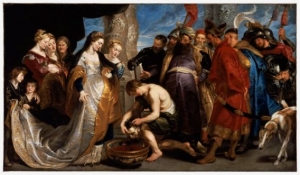
The Museum of Fine Arts, Boston, unveiled on September 8 its newly renovated William I. Koch Gallery, one of the Museum's grandest spaces, evocative of a great hall in a European palace. Masterpieces from the 16th- and 17th-century Italy, France, Spain, and Flanders hang on walls covered in red damask, complemented by a spectacular display of German silver and four tapestries from the Palazzo Barberini in Rome.
"The Koch Gallery is the most majestic architectural space in the MFA, and the new installation enhances this effort, with an astonishing display of European paintings and silver, virtually unparalleled in America," said Malcolm Rogers, Ann and Graham Gund Director of the MFA, who is overseeing the project and a team of Art of Europe curators and designers.
The iconic Koch Gallery features masterpieces drawn from the Museum's renowned European collection. Among the approximately 40 paintings on view are Nicolas Poussin's Mars and Venus (about 1630), Diego Rodriguez de Silva y Velazquez's Don Baltasar Carlos and Dwarf (1632), Peter Paul Rubens's Head of Cyrus Brought to Queen Tomyris (about 1622-23), and Guercino's Semiramis Receiving Word of the Revolt of Babylon (1624). A major conservation effort was undertaking to treat Anthony van Dyck's Isabella, Lady de la Warr (about 1638), which was acquired by the MFA in 1930. It was recently rediscovered in storage, badly in need of attention and a new frame. Also featured in the gallery are select loans, including Frans Francken's Allegory of Man's Choice between Virtue and Vice (Private Collection, 1635).
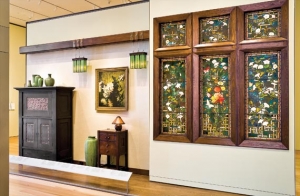
The Lorraine and Alan Bressler Gallery in the new Art of the Americas Wing at the Museum of Fine Arts, Boston, features works inspired by the American Arts and Crafts movement (Fig. 1). Despite the fact that the founding and early formative years of the museum were integrally related to the development of the Arts and Crafts movement in Boston and the United States at large, this is the first time in the MFA’s 140-year history that a significant gallery has been dedicated to this material.
The MFA’s founding in 1870 was in part motivated by design reform efforts begun earlier in the century in England. Design reformers lamented the decline in aesthetic standards brought on by industrial production, and debated the role of art, design, and morality in ornament and manufacture and, by extension, in everyday life. With “Art, Industry, Education” as its motto, the MFA was modeled after London’s South Kensington Museum (now the Victoria and Albert Museum, established in 1852), as a “resource whence artisanship and handicraft of all sorts may better and beautify our dwellings, our ornaments, our garments, our implements of daily life.” 1 The art and artifacts (or copies of originals) shown in the MFA were meant to inspire and educate artists, designers, and the general public, and therefore improve the aesthetic quality of manufactures and domestic settings in Boston and beyond.
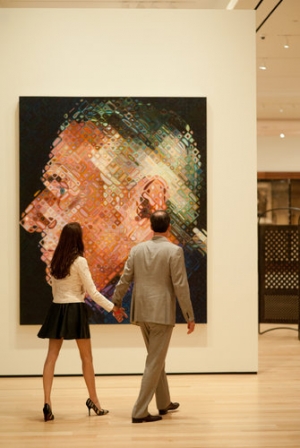
“There’s one thing I’ve heard over and over again here,” says Edward Saywell, the top contemporary art curator at the Museum of Fine Arts, Boston, who is showing off works by Ellsworth Kelly, Kara Walker, Cindy Sherman and other contemporary artists in his domain, including many new ones. “They say, ‘This can’t be Boston,’ and I say, ‘Yes, it really is.’ ”
The people in Mr. Saywell’s tale are marveling at the museum’s new Linde Family Wing for Contemporary Art, an airy 80,000 square-foot space that opened in mid-September, but they may as well be talking about the city as a whole. Boston is known for its wealth of Old Masters, Impressionist paintings and historic American art, not for works by living artists.
But mark fall 2011 as the moment that may change that reputation, and not just because of the Linde wing, whose 24-hour inaugural party managed to muster a small crowd even at 3 a.m., when tickets cost $50, compared with $200 at 7 p.m. (If they had waited until 7 a.m., tickets were free.)
Since September, the Institute of Contemporary Art has been celebrating its 75th birthday and its fifth year in new home, where attendance has shot up to 200,000 a year from 20,000 in its previous site. “Before we got the new building, Jill used to say we were striving to be marginal,” says Barbara Lee, a trustee, referring to the institute’s director, Jill Medvedow.
Now, the Institute of Contemporary Art is credited with helping to revitalize Boston’s waterfront. And under its chief curator, Helen Molesworth, who was hired last year, it is mounting more ambitious exhibitions with prestigious partners like the Tate Modern in London, an important step to gaining influence nationally and internationally.
More change is coming. In January, the Isabella Stewart Gardner Museum, a Venetian-style palazzo full of masterpieces from earlier eras, will open a glass-walled building with new gallery space for temporary exhibitions, including contemporary art.
The List Visual Arts Center at the Massachusetts Institute of Technology will soon have a new director, Paul Ha, who has been the leader of the Contemporary Art Museum in St. Louis in Missouri. There, he improved his museum’s stature and earned a reputation for giving future art stars their first major museum exhibitions.
In 2013, the Harvard Art Museums will open bigger and renovated premises with “a significantly expanded program for the exhibition, study, and interpretation of the art of our time,” says Deborah Martin Kao, its chief curator. And the Massachusetts College of Art and Design, just one of the area’s art schools with a growing student population, is in the midst of an expansion, too.
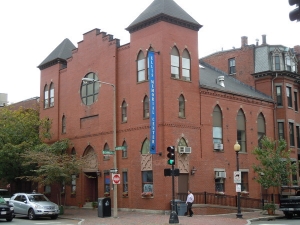
The Ellis Boston Antiques Show is returning to the city this October after a three-year hiatus, re-launching a 49-year tradition that will feature nearly 40 of the finest antiques exhibitors from across the country and around the world.
Housed this year in the Cyclorama, the show kicks off on Thursday, October 20, with a Gala Preview benefiting the South End’s Ellis Memorial & Eldredge House. The show continues on Friday, October 21, and runs through Sunday, October 23.
“The Ellis Antiques show is the tops for New England,” said Marc Glasberg, owner and founder of Boston’s Marcoz Antiques, one of this year’s exhibitors. “It gives the Boston area and dealers a certain charisma regarding antiques.”
In addition to Marcoz Antiques, this year’s Boston exhibitors include Polly Latham Asian Art and Vose Galleries.
“We’re really glad that it’s back,” said Vose Galleries assistant manager Chris Greene. “It’s important to have these types of shows in the city. It really livens up the city’s whole culture.”
Ceramics, Rare Maps, Quilts And Fine Art
The show will feature a range of antiques including ceramics, rare maps and prints, jewelry, quilts, pottery, and fine art, among other items.
“We worked really hard to get a wide array of antiques into the show, both in terms of what they are and in terms of pricing,” said co-producer Tony Fusco of Fusco & Four.
The show was originally established by Ellis Memorial’s Board of Directors in 1960 as a fundraising event.
Fusco contacted Ellis Memorial’s Board of Directors as soon as he heard that the 2009 show would be canceled, and he has been working with his Fusco & Four partner, and event co-producer, Robert Four over the past three years to make the show’s return a success.
“There was a huge vacuum when they closed the show,” he said. “People in the antiques world were shocked. To think that Boston, a city that is totally steeped in history, would not have an antiques show—that shocked people.”
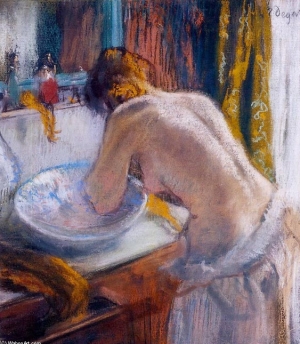
The first museum exhibition devoted exclusively to the extraordinary range of nudes by Edgar Degas—tracing their evolution from the artist’s early years, through the private and public images of brothels and bathers in the 1870s and 1880s, to the post-Impressionist nudes of the end of his career—will be presented by the Museum of Fine Arts, Boston (MFA), and the Musée d’Orsay, Paris. Degas and the Nude, on view October 9, 2011, through February 5, 2012, at the MFA, will offer a groundbreaking examination of Degas’s concept of the human body during the course of 50 years by showing his work within the broader context of his forebears, contemporaries, and followers in 19th-century France, among them Ingres, Delacroix, Cassatt, Caillebotte, Renoir, Toulouse-Lautrec, Matisse, and Picasso. Assembled from the collections of more than 50 lenders from around the world are approximately 165 works—145 by Degas—including paintings, pastels, drawings, monotypes, etchings, lithographs, and sculptures, many of which have never been on view in the United States. After its debut in the MFA’s Ann and Graham Gund Gallery—its only US venue—Degas and the Nude will be shown at the Musée d’Orsay from March 12–July 1, 2012. Presentation of the exhibition in Boston is made possible by Bank of America. This exhibition is supported by an indemnity from the Federal Council on the Arts and the Humanities.
The 19th-century French artist Edgar Degas (1834–1917), a founding member of the Impressionist group who gravitated toward realism, is acclaimed for his mastery of a wide range of genres, which he executed in all media using a variety of techniques. In addition to his famous depictions of ballet dancers or racing subjects, Degas’s work also included history paintings, portraits, landscapes, and scenes of urban leisure. This exhibition, however, will focus entirely on his nudes, illustrating the transformation of Degas’s treatment of the human form throughout half a century—from early life drawings in the 1850s, to overtly sexual imagery, to gritty realist nudes, and beyond to the lyrical and dynamic bodies of the last decade of his working life when the theme dominated his artistic production in all media.
“Degas and the Nude will be a revelation for our visitors. It will offer a number of surprises—for instance, we’ll reunite several of Degas’s black-and-white monotypes with the corresponding pastel ‘twins’ for the first time since they left the artist’s studio,” said Malcolm Rogers, Ann and Graham Gund Director of the MFA. “Visitors will see the progression of his nudes and the very heart of Degas’s fascination with the body and its range of emotion and movement. He pursued that fascination in portraits, and above all in images of dancers, but in the nude we see the body in its purest form…through Degas’s eye and imagination.”
Degas and the Nude draws from some of the finest collections in the world. In addition to the MFA and Musée d’Orsay—the single largest lender, with more than 60 works—these include the National Gallery and Courtauld Gallery, London; the Musée Andre Malraux, Le Havre; museums and private collections in Germany, Japan, and Switzerland; as well as the Metropolitan Museum of Art, the Art Institute of Chicago, and the Philadelphia Museum of Art, among many other museums and private collections in North America. The exhibition will feature such masterpieces as Young Spartans Exercising (1860-62, National Gallery, London) and Scene of War in the Middle Ages (1863–65, Musée d’Orsay, Paris), two of Degas’s greatest history paintings; and The Tub (about 1886, Musée d’Orsay), a pastel completed at the height of his career and presented at the last Impressionist exhibition in 1886. It will also offer context to this exploration of the artist’s nudes by juxtaposing his works with those created by major artists who influenced—or were influenced by—Degas, including Ingres’s Angelica Saved by Ruggiero (1819-39, National Gallery, London), Caillebotte’s Man at his Bath (1884, Private Collection), and Picasso’s Nude on a Red Background (1906, Musée de l'Orangerie, Paris).
More than three years in the making, Degas and the Nude was conceived by George T.M. Shackelford, Chair, Art of Europe and Arthur K. Solomon Curator of Modern Art at the MFA, who co-organized the exhibition with Xavier Rey, Curator of Paintings, Musée d'Orsay. “Our project explores how Degas exploited all of the body’s expressive possibilities,” Shackelford said. “It shows how his personal vision of the nude informed his notion of modernity, and how he abandoned the classical or historical form in favor of a figure seen in her own time and setting, whether engaged in shockingly carnal acts or just stepping out of an ordinary bath.”
“The first works by Degas to enter the collections of the French State were pastels of nudes bequeathed to the nation by Gustave Caillebotte in 1894,” said Xavier Rey, exhibition co-curator. “In the ensuing century, the Musée d’Orsay has become The Tub, 1886, Edgar Degas the world’s greatest repository of Degas’s depictions of the nude—in paintings, pastels, drawings, and sculpture. We take pride in co-organizing this major international project, which will be one of the important exhibitions in Paris in 2012.”
Degas and the Nude is organized into six sections, which will explore:
- Degas’s earliest nudes, from about 1855 to 1862
- The artist’s early masterwork, Scene of War in the Middle Ages, and the studies that preceded it
- Brothel monotypes Degas executed in the latter half of the 1870s
- Transformation of Degas’s brothel imagery to scenes of daily life
- Select works from the artist’s key years of 1884–86
- Degas’s last years as an artist, from about 1890 to 1905
The exhibition will begin with a selection of the artist’s first nudes, including Study of Michelangelo’s Bound Slave (1855–60, Private Collection), one of Degas’s many studies of works by Renaissance artists that he made in Paris or in Italy, where he drew from live models at Rome’s French Academy. Many life studies and paintings created as part of this early academic training will be on display, as well as drawings made for early figural compositions, culminating in the painting Young Spartans Exercising (1860–62, National Gallery, London), a depiction of girls beckoning or taunting a group of boys, with the landscape of ancient Sparta as a background.
One of Degas’s most notable works incorporating nudes, the history painting Scene of War in the Middle Ages, will be the focal point of the second section of the exhibition. The often overlooked masterpiece was the first work Degas exhibited at the official Salon in 1865. It will offer an early view of some of the many poses the artist would repeat throughout his career. Complementing it will be more than a dozen of the studies that preceded it, as well as works by other artists who exerted an influence on Degas in the conception and elaboration of the painting, such as Jean Auguste Dominique Ingres (1780–1867), whose Angelica Saved by Ruggiero will be displayed along with a masterwork by Eugène Delacroix (1798–1863): The Death of Sardanapalus (1844, Philadelphia Museum of Art). These two French masters, as well as artists such as Francisco de Goya y Lucientes (1746–1828) and Pierre Puvis de Chavannes (1824–1898), provided inspiration for the young Degas. Two paintings by Degas from the later 1860s also will be shown: Interior (The Rape) (1868–69, Philadelphia Museum of Art) and Peasant Girls Bathing in the Sea at Dusk (about 1869, revised later, Private Collection).
The exhibition’s third section will be devoted to the brothel monotypes that Degas executed in the latter half of the 1870s— images that are at times caricature-like, ironic, pornographic, or even unexpectedly tender. These often sexually explicit scenes depict women in brothels: waiting for clients, as in The Reluctant Client (1876-77, National Gallery of Canada), and engaging in sexual acts, as in Two Women (1876–77, MFA). Most of these works are relatively small in scale, made as drawings using brush and greasy ink on metal plates, which were then printed to yield one proof (“mono-type”); sometimes a second, fainter, impression was taken. The monotypes were occasionally touched with pastel; some—more often the second impressions—were completely covered with color to become small pictures, ready for sale or gift.
The evolution of Degas’s nudes will continue in a following section, shifting from overtly sexual imagery to the everyday, “naturalist” nudes, as seen in the artist’s spontaneous views of ordinary, seemingly unposed women at various stages of undress or performing “la toilette”—bathing, drying, or grooming themselves. These monotypes will highlight the emergence of the bather as a central theme in Degas’s art—one that he would explore from the middle of the 1880s until the end of his career. Many of these later monotypes were made in a way that differed from the first ones, showing the artist’s interest in exploring a variety of techniques and materials. Rather than painting his image with a brush, Degas inked the entire plate and “pulled” the image out of the ink with selective wiping and scraping. In this section, some monotypes will be united with their corresponding pastels for what is believed to be the first time. These include the monotype Woman in a Bathtub (about 1850–85, Private Collection), and the pastel over monotype Woman in Her Bath, Sponging her Leg (1883–84, Musée d’Orsay). Other pastels and oil paintings will be featured here, as well as comparisons to the work of Mary Stevenson Cassatt (1844–1926), Woman Bathing (1890–91, The Metropolitan Museum of Art), and Henri de Toulouse-Lautrec (1864–1901), La Toilette (Rousse) (1889, Musée d’Orsay). The section will culminate in a group of large-scale oil paintings by Degas and his friends Gustave Caillbotte (1848–1894) and Henri Gervex (1852–1929), made between the years 1878 and about 1884.
Works from a pivotal time in Degas’s career, 1884–86, will be examined in section five of the exhibition. Two examples, The Tub (1885–86, Musée d’Orsay) and Woman Dressing Herself (1885–86, National Gallery of Art, Washington, DC) were included in the last Impressionist exhibition, held in Paris in the spring of 1886. In addition, comparative paintings by Pierre- Auguste Renoir (1841–1919), Woman Combing Her Hair (1882–83, Private Collection), and Puvis de Chavannes, Young Woman at Her Toilette (1883, Musée d’Orsay), will be displayed, as well as works from the late 1880s that expand upon those created a few years earlier. Also included will be the sculpture The Tub (Musée d’Orsay, 1889 modeled, cast 1920–21), cast in bronze after the artist’s death.
Degas and the Nude will conclude with an exploration of Degas’s last years as an artist, from about 1890 to 1905. “During this period, Degas is focused almost exclusively on the bather, with the exception of a few great drawings and sculptures depicting dancers. His color sense grows bolder, and as he nears the end of the 1890s, his painting and drawing technique become more experimental and, likewise, more bold,” explained Shackelford. “Influences of such artists as Gauguin and Rodin are felt in his painted compositions and sculpture. Sinuous lines, sensual hatchings, delicate blending and shading, and large scale mark his later charcoal drawings of bathers, among the most accomplished sheets in his career, and a radical departure from the carefully rendered nudes of 1855–1865.” Featured here will be the largest single grouping in the exhibition, which will showcase Degas’s masterpieces, After the Bath (about 1896, Philadelphia Museum of Art) and After the Bath (1895-1900, The Phillips Collection, Washington, DC). In addition, to illustrate Degas’s influence on the next generation of great artists, paintings by Degas will be juxtaposed with those by Pierre Bonnard (1867–1947), Henry Matisse (1889–1954), and Pablo Picasso (1881–1973). In the context of Degas’s great nudes of the 1890s, Bonnard’s Indolence (1899, Musée d’Orsay), Matisse’s Carmelina (1903, MFA), and Picasso’s Nude on a Red Background (1906, Musée de l'Orangerie, Paris) take on new meaning, as masterworks by the youthful standard-bearers of Degas’s post-Impressionist style in a new century.
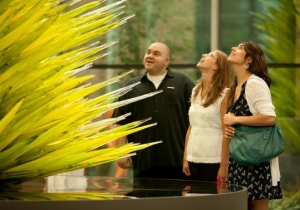
They’ve waited in line for hours, blogged their rave reviews, and begged the Museum of Fine Arts to keep the tower of green glass even after the smash success Dale Chihuly exhibition closes.
Now, visitors to the Museum of Fine Arts are being given a chance to put their money behind their pleas.
The MFA has launched a campaign to raise more than $1 million to buy the 42-foot-tall “Lime Green Icicle Tower,’’ a signature work by the glass artist that’s been grabbing attention in the museum’s new Shapiro Family Courtyard since “Chihuly: Through the Looking Glass’’ opened in April. The public contributions will be matched by those of a group of longtime MFA donors.
It is fairly standard, these days, for a museum to acquire a work from an artist who has been featured in a solo exhibition. But typically, deep-pocketed donors are sought to make those purchases. The MFA’s public appeal includes, for the first time, a chance for museum visitors to give online and by texting on their phones - people can text the word TOWER to 50555, then reply to the follow-up message “To confirm your $10 donation to MFA Boston, reply with the word YES.’’
“People indicated clearly they wanted the piece to stay,’’ said Malcolm Rogers, the MFA director. “Many ordinary people indicated they wanted to give. It’s a great opportunity for people to give in a quite modest way and feel they contributed to making this a great place.’’
The MFA quietly began the campaign last week by adding a donation box next to the piece and sending an e-mail to museum members pointing them to the contribution website. This week, they plan to add tweets and Facebook posts to spread the word.
And later in August, an e-mail blast detailing the campaign will go out to anyone who has visited the Chihuly show. In recent weekends, people have waited hours to see the artist’s works. This week, attendance surpassed 320,000, meaning that when Chihuly closes Aug. 7, it will be at least the fifth-most-visited MFA exhibit of all time, behind just “Monet in the 20th Century,’’ “Monet in the ’90s,’’ “Renoir,’’ and “Pompeii 79 A.D.,’’ which were held in 1999, 1990, 1986, and 1978, respectively.

The Institute of Contemporary Art/Boston (ICA) presents Catherine Opie: Empty and Full, on view at the ICA from April 15 through Sept. 5, 2011. Exhibition presents new work on view for the first time.
This spring, the Institute of Contemporary Art/Boston opens Catherine Opie: Empty and Full, an exhibition of new and recent work by photographer Catherine Opie. One of the defining artists of her generation, Opie is known for her portraits and landscapes. In this exhibition, Opie has taken photographs of recent political demonstrations and gatherings—ranging from the inauguration of President Obama to Tea Party rallies. Her work explores the intimate relations between community and politics, citizens and the landscape, offering a dynamic portrait of the United States at the dawn of the twenty-first century. Organized by ICA Chief Curator Helen Molesworth, Catherine Opie: Empty and Full is on view at the ICA from April 15 through Sept. 5, 2011.
“Catherine Opie: Empty and Full is a timely exhibition by an important artist, whose work continues to pose and frame questions about the most basic human values: love, community, family, and freedom,” says Jill Medvedow, director of the ICA.
“Opie’s recent work elaborates on the relationship between people and place, particularly the energy and desires created when masses of people convene around a shared interest or value,” says Molesworth. “Freedom of assembly is one of the rights Americans take for granted and Opie is interested in the way that sites, such as the National Mall in Washington, D.C., come to be defined by the groups of people who assemble there and how their gathering shapes the identity of the place. Drawing on the long and august tradition of American landscape painting and documentary photography, Opie ultimately gives us a picture of a great experiment: democracy in action.”
The first series is entitled Inauguration and documents the enormous crowds that convened in Washington, D.C., for President Barack Obama’s inauguration. These images show us portraits of Americans assembled en masse on the Mall, bundled up against the January cold to await the arrival of the new president. Shot against a landscape of pale winter light and bare trees, Opie’s photographs capture moments of individual emotion on a day that recognized the hopes and voices of an American majority.
Other works are images of the Michigan Womyn’s Music Festival and the annual convening of the Boy Scouts of America. These works further Opie’s interest in the specific use made of the landscape, as well as her ideas about the wide variety of ideals and beliefs held by Americans in their pursuit of a meaningful life. These lush and pastoral images are held in contrast with images Opie has been taking of political protests in urban areas, notably Tea Party rallies, pro-immigration marches, and anti-war demonstrations. A comparison is made between urban and rural, pleasure and protest, leisure and commitment, all of which add up to a rich and complex view of the United States, our citizens and our deeply engrained relationship to the landscape.
Installed around the perimeter of the ICA gallery is a series of devastatingly beautiful images of the ocean. These images, from a body of work called Twelve Miles to the Horizon, were taken over a period of ten days, one at every sunrise and one at every sunset, from the deck of a massive container ship making the passage from Busan, Korea, to Long Beach, California. These pictures of sunrises and sunsets all share the same horizon line, are radically unpopulated, and are feats of technical precision and sublime beauty. Their “emptiness” stands in stark contrast to the fullness of the political pictures.
Despite the formal differences between the two “types” of images on view in Empty and Full, there is also a strain of continuity. In each body of work, Opie suggests a profound level of interconnection and interdependence that people have not only with one another, but with the spaces we collectively inhabit.
Artist bio
Born in 1961 in Sandusky, Ohio, Catherine Opie has become one of America’s premier documentarians, photographing the American landscape—from its Alaskan glaciers to its suburban freeways—as frequently as she images its citizens. A graduate of Cal Arts, she currently teaches in the studio program at the University of California at Los Angeles. Select solo exhibitions include Catherine Opie: Figure and Landscape at the Los Angeles County Museum of Art (2010), Catherine Opie: American Photographer at the Guggenheim Museum in New York (2008), Catherine Opie: Chicago at the Museum of Contemporary Art Chicago (2006). Opie was a 2009 recipient of the President’s Award for Lifetime Achievement from the Women’s Caucus for Art and was awarded a United States Artists Fellowship in 2006.
The exhibition is made possible with the generous support of the Robert Mapplethorpe Foundation, Mark and Marie Schwartz, the Barbara Lee Family Foundation, Sandy and Les Nanberg and Regen Projects.
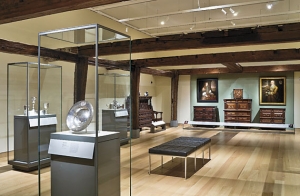
While the newly opened Art of the Americas Wing at the Museum of Fine Arts, Boston, offers a hemispheric view of 3,000 years of North, Central, and South American art, the period rooms tell a distinctly local story. Of the eight period rooms and other architectural elements interspersed within fifty-three new galleries, six of these rooms make their return to public view after a hiatus of nearly eight years, now carefully restored and rethought for a new generation of visitors. Two other rooms are on view for the first time. The American period rooms have been a popular part of the MFA’s displays since they were first installed in the former Decorative Arts Wing of the museum, which opened to the public in 1928. Now, as then, the rooms focus on New England, complementing the MFA’s significant holdings of colonial and nineteenth-century art from New England. The most elaborate and well known of the period rooms are those from Oak Hill, Samuel McIntire’s 1800–1801 architectural masterpiece created in Peabody, Massachusetts, for the Derby-West family and filled with luxurious furnishings and exquisite examples of his carved furniture. The three Oak Hill rooms now sit comfortably alongside a gallery devoted to the furniture of John and Thomas Seymour (who were heavily patronized by the Derby-West family) and the neoclassical silver of Paul Revere. Other rooms now reinstalled include the 1730 Jaffrey parlor and the 1803 Shepard parlor, with its original French scenic wallpaper. Two newly installed rooms from the 1840 Roswell Gleason House in Dorchester inform adjacent galleries of mid-nineteenth-century paintings and decorative arts; the earliest timber-frame structures—the 1692–1693 Manning frame and the 1704 Brown-Pear hall—are placed in spirited dialogue with the museum’s important collection of early Anglo artifacts arranged within and around their walls. Throughout, the period rooms inform our sense of place and scale, while providing a more intimate encounter with art.
|
|
|
|
|